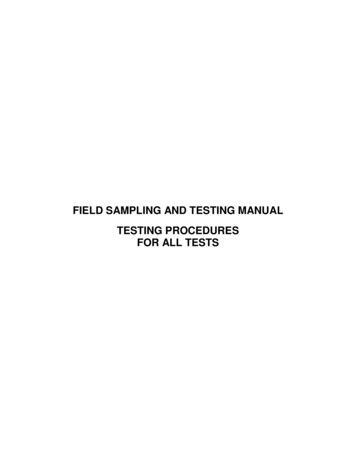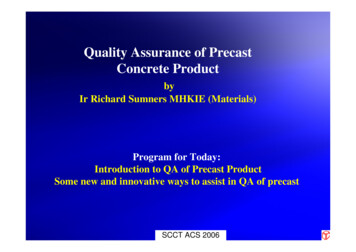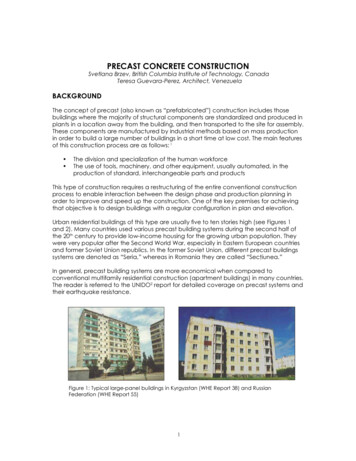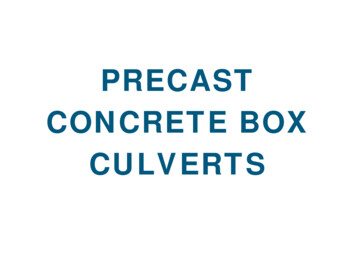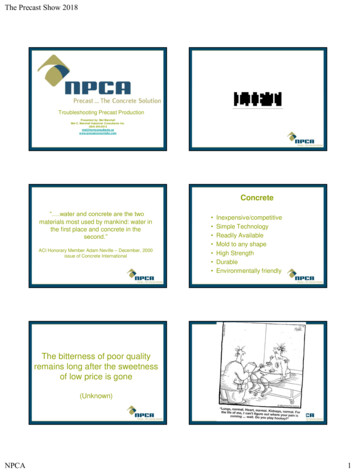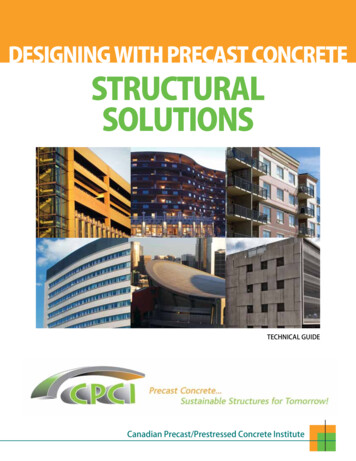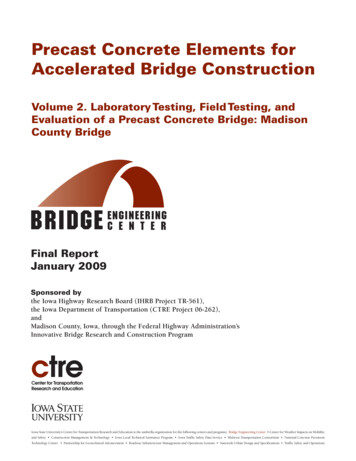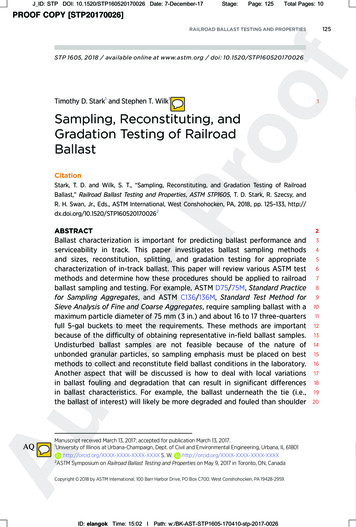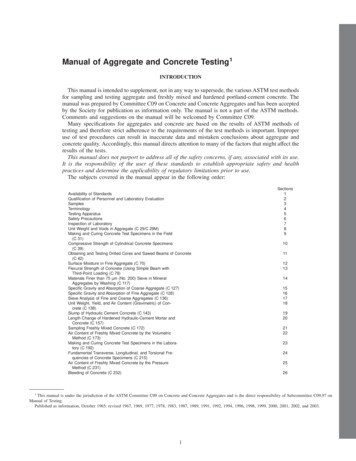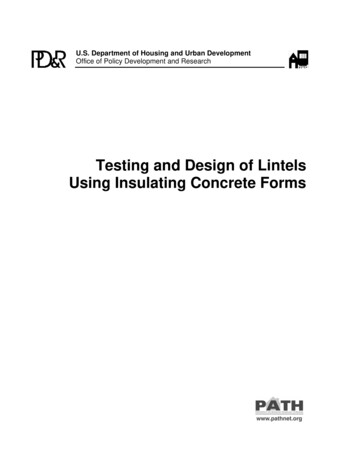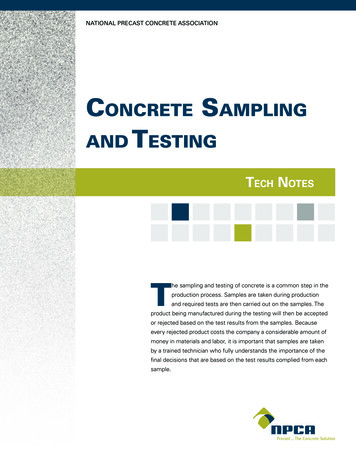
Transcription
NATIONAL PRECAST CONCRETE ASSOCIATIONConcrete Samplingand TestingTech NotesThe sampling and testing of concrete is a common step in theproduction process. Samples are taken during productionand required tests are then carried out on the samples. Theproduct being manufactured during the testing will then be acceptedor rejected based on the test results from the samples. Becauseevery rejected product costs the company a considerable amount ofmoney in materials and labor, it is important that samples are takenby a trained technician who fully understands the importance of thefinal decisions that are based on the test results complied from eachsample.
The type and frequency of testing are generallyoutlined by the engineer in charge in the jobspecifications. Some or all of the concretetests mentioned in this TechNote may be required.SamplingProper sampling methods are required to obtainrepresentative test results on fresh concrete. Toachieve a truly random unbiased sample, follow ASTMD 3665, “Standard Practice for Random Sampling ofConstruction.” Avoid taking samples from the firstand last portions of a batch to obtain a representativesample. Take samples soon after the batch is made toobtain proper temperature and moisture content.Applicable Standards ASTM C172/C172M, “10 Standard Practice forSampling Freshly Mixed Concrete” ASTM D 3665, “Standard Practice for RandomSampling of Construction” CSA A23.2-1C, “Sampling Plastic Concrete”Testingconcrete performance, but for creating possible costsavings. Mix-water and aggregate temperatures,boiler energy, curing-equipment energy and buildingheat may all be adjusted to achieve the optimumcuring temperatures. Creating the optimum curingenvironment can also result in overall energy savings.Applicable standards ASTM C1064/C1064M-12, “Standard Test MethodTestingfor TemperatureWhen performing temperature tests, it is important touse a good, accurate thermometer that is surroundedby at least three inches of concrete. Take readingsquickly, noting that small samples lose heat fast.Concrete temperatures are affected by the mix-watertemperature, aggregate temperatures, cement typeand admixture type. Optimum concrete temperatureswill aid with setting, early strength development,proper curing and ultimately aid in achieving a higherquality concrete. Hot concrete sets up rapidly, gainingearly initial strength but resulting in lower finalstrengths. Cold concrete can delay curing and strippingtime and affect productivity.Temperature tests are useful, not only in determining2 Tech Notes - Title precast.orgfor Temperature of Freshly Mixed HydraulicCement Concrete” CSA A23.2-17C, “Temperature of Freshly MixedHydraulic Cement Concrete”TestingforAir ContentThe main reason for entraining air in concrete isto control damage from freeze thaw cycles. Airtests determine the total content of entrained andentrapped air in concrete. During batching and mixingtiny air bubbles are created in the concrete mix. Ifthe concrete contains an air-entraining admixture,these bubbles remain stabilized in the mix due tothe electrostatic binding of air, water and cement. Inconcrete without air entrainment, all but about 2% ofthe air content escapes or dissolves after consolidation
because the bubbles are not bonded to the water andcement. The remaining air is called “entrapped” air.Entrapped air will not aid in preventing freeze thawdamage.Applicable Standards ASTM C231/C231M-10, “Standard Test Methodfor Air Content of Freshly Mixed Concrete by thePressure Method”It is important to introduce air-entraining admixturesearly in the mix cycle to maximize their potential. It is CSA A23.2-4C, “Air Content of Plastic Concreteby the Pressure Method”also important to carefully control the addition of airThe volumetric method is used for dry- cast mixesentrainment. Too much air will result in considerableand lightweight concrete. With this method, water isstrength loss.added to a known volume of concrete. The apparatusCertain properties and materials in fresh concrete havean effect on air content. Some admixtures, fly ash andcarbon containing pigments will influence air content.Temperature, aggregate size and the amount of mixwater can also have an impact.containing the sample is then agitated to release theair. The amount of water displaced equals the volumeof air in the mix.Applicable Standards ASTM C173/C173M-12, “Standard Test MethodThe pressure method is used for mixes containingfor Air Content of Freshly Mixed Concrete by thenormal to heavy-weight aggregate. Applying aVolumetric Method”predetermined pressure to a calculated sample volumeof concrete squeezes out the air. This results in a CSA A23.2-7C, “Air Content of Plastic Concreteby the Volumetric Method”pressure drop that corresponds to the percentage ofair in the concrete sample. It is important to calibrateyour air meter regularly to ensure accurate readings.Testing for Density and YieldThis test is used to determine density (unit weight),yield and air content. After the density is determined,the yield and air content can then be calculated usinggiven formulas.Density (unit weight) is a measure of weight per unitvolume and is expressed in lbs/ft³ or kg/m³. The densityof fresh concrete is similar to the density of hardenedconcrete. After the unit weight is determined, yieldcan be calculated. Yield is the ratio of total weight ofmix material batched for a designed volume to theactual concrete density. It can also be expressed asthe volume of concrete produced per batch. Yield willindicate if a mix proportioning problem exists.The density test is also a quick method for checkingthe air content of concrete. After the density and yieldare determined, the air content can be calculated. Thismethod should not replace volume or pressure testingmethods for air content measurements. This test isalso not appropriate for determining the air content oflightweight concrete.3 Tech Notes - Title precast.org
Applicable Standards ASTM C138/C138M-12a, “Standard Test Methodis its compressive strength. Testing for compressivestrength helps determine whether a product meetsfor Density (Unit Weight), Yield, and Air Contentspecified strength requirements, when to strip forms,(Gravimetric) of Concrete”and when a product is ready for shipping and service. CSA A23.2-6C-Density, “Yield, and CementingMaterials Factor of Plastic Concrete”Strength results are also used for evaluating mixdesigns. Cylinders are usually tested in pairs to verifyresults and to rule out erroneous information based onMaking and Curing Concrete TestSpecimensunsatisfactory breaks.The objective of compressive-strength testing ofThis test describes how cylindrical concrete testconcrete cylinders is to determine the amount ofspecimens are made. Cylinder sizes are usually 6 in.force it takes to break a cylinder of concrete. A testx 12 in. or the more common 4 in. x 8 in. The sizecylinder is placed in a compression-testing machine,is either specified in job requirements or based onand a constant load is applied to the cylinder until itpersonal preference.breaks. The compressive strength is calculated basedCuring techniques for test samples are importantand the method chosen depends on the product andcustomer specifications. Test specimens are usuallyon the applied load and the size of the test cylinder. Itis important to center the cylinder between the loadingplates and to apply the load at a constant rate.cured in a lime-water bath to verify the mix design andLoading rates, sample alignment and cappingto determine the potential of the mix. Sometimes it isprocedures can affect the results. Improper cappingnecessary to cure samples in the exact environmentalor surface irregularities of specimens will causeconditions where the product will be installed in ordera non-uniform load, yielding improper results. Theto assess its performance in the field.proper method for capping is described in ASTM CA sufficient number of specimens should be madeto cover both laboratory and field requirements. Forexample, making eight cylinders would allow two eachfor testing stripping strengths, 7-day strengths, 28day strengths, and two extra for testing of shippingstrengths.617, “Practice for Capping Cylinders.” End grindersor rubber caps can also be used to prepare andtest concrete test specimens. The type of breakof a cylinder needs to be assessed and should beclassified according to Figure 2 of ASTM C39. Thebreak type that yields the most accurate reading is thehourglass. Other types may yield erroneous strengthApplicable Standards ASTM C31/C31M-12, “Standard Practice forMaking and Curing Concrete Test Specimens inthe Fieldvalues. Compressive testing machines require propercalibration to ensure accurate results and should be recalibrated according to applicable standards.Applicable Standards A23.2-3C, “Making and Curing ConcreteCompression and Flexural Test Specimens” ASTM C39/C39M-12a, “Standard Test Methodfor Compressive Strength of Cylindrical ConcreteSpecimens”TestingforCompressive StrengthOne of the most important properties of concrete4 Tech Notes - Title precast.org ASTM C617/C617M-12, “Standard Practice forCapping Cylindrical Concrete Specimens”
CSA A23.2-9C, “Compressive Strength ofCylindrica l Concrete Specimens”ConclusionTesting Finished ProductsTesting provides information to evaluate and adjustSome government agencies and contracts require testmix designs, including the quality and quantity ofsamples to be extracted from the finished products, orraw materials used in the concrete mixes. Evaluatingin situ testing of the completed structure. This can betest information enables manufacturers to adapt todone by using core samples or by performing impactconstantly fluctuating conditions such as seasonalhammer testing.temperature changes and job specifications.Applicable StandardsTesting aids in production planning and provides ASTM C42/C42M-13, “Standard Test Method forinformation to increase efficiency, which can positivelyObtaining and Testing Drilled Cores and Sawedimpact production volumes and on-time delivery.Beams of Concrete”Testing also allows measuring not only of the quality ASTM C805/C805M-13, “Standard Test Methodof specific products but also provides a way to followfor Rebound Number of Hardened Concrete”production and quality trends over time. An ongoing CSA A23.2-14C, “Obtaining and Testing DrilledCores for Compressive Strength Testing”commitment to quality is established by performingthe tests described and maintaining a complete record.This publication is designed to provide accurate and authoritative information, however the National Precast ConcreteAssociation does not guarantee the validity or accuracy of any data, claim or opinion appearing in this publication. Ifengineering, legal or other professional services are required, the services of a competent professional should beobtained. The National Precast Concrete Association does not assume and hereby disclaims liability to any person forany loss or damage caused by errors or omissions in this publication, regardless of whether such errors result fromnegligence, accident or any other cause whatsoever.5 Tech Notes - Title precast.orgMarch 2013
ASTM C31/C31M-12, “Standard Practice for Making and Curing Concrete Test Specimens in the Field A23.2-3C, “Making and Curing Concrete Compression and Flexural Test Specimens” TeSTing for CompreSSive STrengTh One of the most important properties of concrete is its compressive strength. Testing for compressive strength helps determine whether a product meets specified strength .
